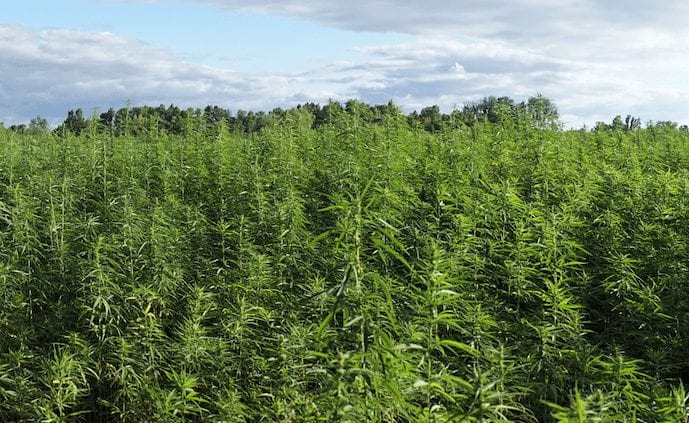
“Absent intense research and collection of hard data that will be interesting to conduct as we move forward and funding becomes available, experts agree that a distance of ten (10) miles between hemp and marijuana fields is exceedingly appropriate to avoid cross-pollination.”
While hemp and ganja are grown differently, and used for different purposes, they share the same botanical genus and species, Cannabis sativa. Since they’re both scientifically ‘cannabis’, in this discussion I refer to cannabis grown for medicinal use as ganja. Of course, if real science was used to make public policy, then hemp would never have been outlawed just because its cousin, ganja, has psychoactive properties.
Now that prohibition appears to be sunsetting for both forms of Cannabis sativa, more research is needed to understand how closely these two cousins can co-exist in the real world. Cross-pollination is undesirable for the hemp farmer, and potentially disastrous for the ganja farmer. However this potential for damage is easily mitigated with a bit of distance between the two crops.
Since the superiority of growing sinsemilla (meaning “no seeds” in Spanish) began in the 1970s, it quickly spread as the best way to grow ganja. The key was the discovery that when a female ganja plant receives no pollen from a male plant, it produces potent flowering blossoms with no seeds. This is why ganja farmers who grow from seed carefully inspected their young plants for signs of their sex, and cull the male plants as soon as they reveal themselves. They know that it only takes one male plant in the garden to fling its pollen around and pollinate many to all of the female’s stigmas (the reproduction organ where pollination occurs), which then bear flowers bursting full of seeds. So-called ‘seedy weed’ is far lower in quality. This is due not only to the fact that seeds must be removed before it can be smoked or vaped, but also because the energy of a pollinated plant focuses on seed production instead of the production of trichomes.
Seed breeders carefully isolate pollen and pollinate select female stigmas by hand while ensuring that no pollen escapes to cause random pollinations. The thought of a future where male hemp plants are freely left in the fields alongside the female hemp plants, throwing their pollen to the wind to potentially find female stigmas, can understandably evoke terror in ganja farmers. However the science is limited, so the debate continues to be largely theoretical.
As Jerry Norton of Oregon has learned, the debate can get hot. Norton became the target of suspicion and loathing for many outdoor ganja farmers in Marion County when he obtained a license to grow hemp. Last year, Norton grew both psychoactive ganja and industrial hemp outdoors in a Marion County field as an experiment. He also grew numerous hemp plants in a greenhouse that also contained several ganja plants. Norton claims that, despite their close proximity to male hemp plants, female ganja plants developed a minimal number of seeds. This lack of ‘seedy weed’ makes him optimistic that hemp and ganja growers will find a way to coexist in Oregon using mapping systems to avoid cross-pollination, similarly to those used by specialty seed producers.
Oregon-based horticulturalist Todd Dalotto of CAN! Research, an education and consulting firm, claims that a three mile distance between ganja and hemp could likely generate one seed per ganja plant at most. This means that the risk of contamination is not entirely avoided, but such a loss is very minimal. Dalotto estimates that a ganja farm that is one-to-two miles away from a twenty acre (about five city blocks) hemp farm should expect to see a few seeds per plant.
One estimate of the safe distance to eliminate any cross-pollination between hemp and ganja plants is a Russian study mentioned by a plant breeding specialist in a white paper called “Hemp and Marijuana: Myths & Realities.” David P. West, Ph.D. talks about this Russian study in the context of debunking the myth that hemp should continue to be illegal because it would be used to hide psychoactive ganja plants. However it should be noted that West fails to provide the full title of the Russian study, or cite where it could be found.
David P. West, Ph.D. writes:
“Hemp fields, in fact, could be a deterrent to marijuana growers. A strong case can be made that the best way to reduce the THC level of marijuana grown outdoors would be to grow industrial hemp near it. An experiment in Russia found that hemp pollen could travel 12 kilometers. This would mean that a hemp field would create a zone with a 12-kilometer radius within which no marijuana grower would want to establish a crop.”
Twelve kilometers is the equivalent of about seven and a half miles. This is not far from the 10 mile distance between ganja and hemp farms that is recommended by industrial hemp agrologist Professor Anndrea Hermann. Hermann has helped craft hemp regulations in Canada, the European Union, South Africa, Uruguay, Australia, New Zealand, and several U.S. States.
When asked about the safe distance between hemp and ganja crops for a story in the Seattle Post-Intelligencer, Hermann wrote:
“Absent intense research and collection of hard data that will be interesting to conduct as we move forward and funding becomes available, experts agree that a distance of ten (10) miles between hemp and marijuana fields is exceedingly appropriate to avoid cross-pollination.”
So until more scientific study is conducted, a conservative rule of thumb is 10 miles to keep these two valuable cousins from kissing. With good communication and growing practices between farmers, ganja and hemp can co-exist as keys to a resurgence of healthy and sustainable agriculture.
Written by Kerry Reynolds



Leave a Reply